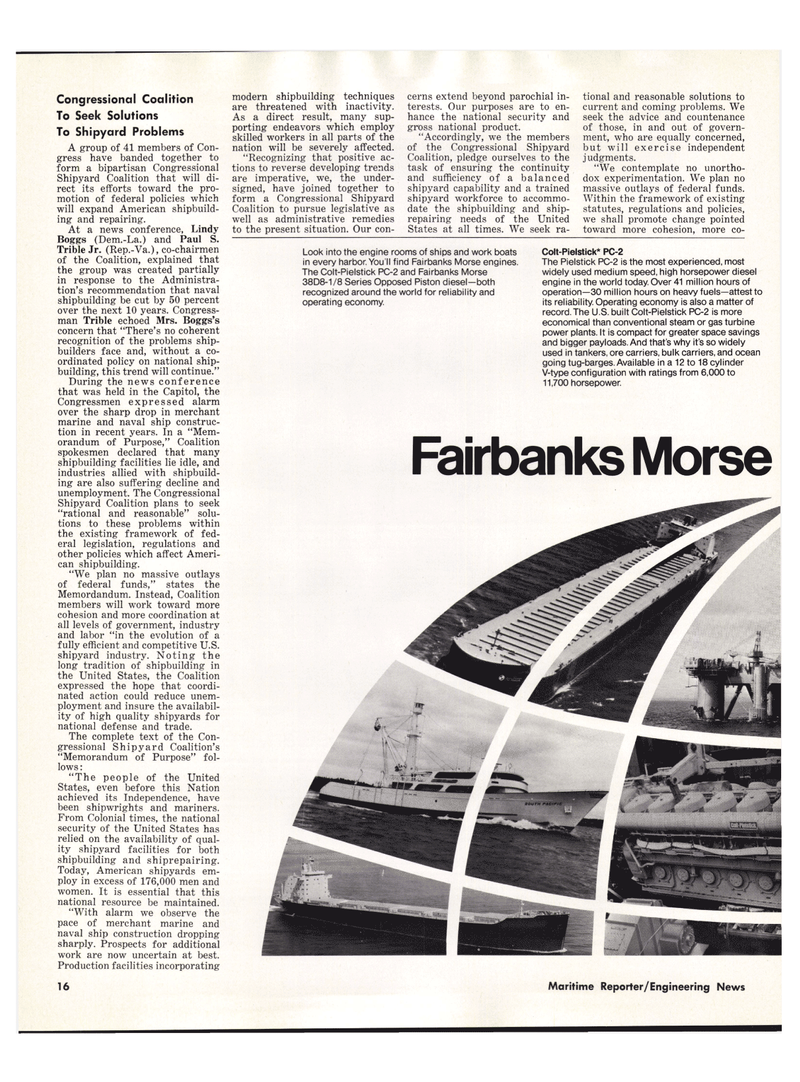
Page 16: of Maritime Reporter Magazine (December 1978)
Read this page in Pdf, Flash or Html5 edition of December 1978 Maritime Reporter Magazine
Congressional Coalition
To Seek Solutions
To Shipyard Problems
A group of 41 members of Con- gress have banded together to form a bipartisan Congressional
Shipyard Coalition that will di- rect its efforts toward the pro- motion of federal policies which will expand American shipbuild- ing and repairing.
At a news conference, Lindy
Boggs (Dem.-La.) and Paul S.
Trible Jr. (Rep.-Va.), co-chairmen of the Coalition, explained that the group was created partially in response to the Administra- tion's recommendation that naval shipbuilding be cut by 50 percent over the next 10 years. Congress- man Trible echoed Mrs. Boggs's concern that "There's no coherent recognition of the problems ship- builders face and, without a co- ordinated policy on national ship- building, this trend will continue."
During the news conference that was held in the Capitol, the
Congressmen expressed alarm over the sharp drop in merchant marine and naval ship construc- tion in recent years. In a "Mem- orandum of Purpose," Coalition spokesmen declared that many shipbuilding facilities lie idle, and industries allied with shipbuild- ing are also suffering decline and unemployment. The Congressional
Shipyard Coalition plans to seek "rational and reasonable" solu- tions to these problems within the existing framework of fed- eral legislation, regulations and other policies which affect Ameri- can shipbuilding. "We plan no massive outlays of federal funds," states the
Memordandum. Instead, Coalition members will work toward more cohesion and more coordination at all levels of government, industry and labor "in the evolution of a fully efficient and competitive U.S. shipyard industry. Noting the long tradition of shipbuilding in the United States, the Coalition expressed the hope that coordi- nated action could reduce unem- ployment and insure the availabil- ity of high quality shipyards for national defense and trade.
The complete text of the Con- gressional Shipyard Coalition's "Memorandum of Purpose" fol- lows: "The people of the United
States, even before this Nation achieved its Independence, have been shipwrights and mariners.
From Colonial times, the national security of the United States has relied on the availability of qual- ity shipyard facilities for both shipbuilding and shiprepairing.
Today, American shipyards em- ploy in excess of 176,000 men and women. It is essential that this national resource be maintained. "With alarm we observe the pace of merchant marine and naval ship construction dropping sharply. Prospects for additional work are now uncertain at best.
Production facilities incorporating modern shipbuilding techniques are threatened with inactivity.
As a direct result, many sup- porting endeavors which employ skilled workers in all parts of the nation will be severely affected. "Recognizing that positive ac- tions to reverse developing trends are imperative, we, the under- signed, have joined together to form a Congressional Shipyard
Coalition to pursue legislative as well as administrative remedies to the present situation. Our con- cerns extend beyond parochial in- terests. Our purposes are to en- hance the national security and gross national product. "Accordingly, we the members of the Congressional Shipyard
Coalition, pledge ourselves to the task of ensuring the continuity and sufficiency of a balanced shipyard capability and a trained shipyard workforce to accommo- date the shipbuilding and ship- repairing needs of the United
States at all times. We seek ra- tional and reasonable solutions to current and coming problems. We seek the advice and countenance of those, in and out of govern- ment, who are equally concerned, but will exercise independent judgments. "We contemplate no unortho- dox experimentation. We plan no massive outlays of federal funds.
Within the framework of existing statutes, regulations and policies, we shall promote change pointed toward more cohesion, more co-
Look into the engine rooms of ships and work boats in every harbor. You'll find Fairbanks Morse engines.
The Colt-Pielstick PC-2 and Fairbanks Morse 38D8-1/8 Series Opposed Piston diesel—both recognized around the world for reliability and operating economy.
Colt-Pielstick* PC-2
The Pielstick PC-2 is the most experienced, most widely used medium speed, high horsepower diesel engine in the world today. Over 41 million hours of operation—30 million hours on heavy fuels—attest to its reliability. Operating economy is also a matter of record. The U.S. built Colt-Pielstick PC-2 is more economical than conventional steam or gas turbine power plants. It is compact for greater space savings and bigger payloads. And that's why it's so widely used in tankers, ore carriers, bulk carriers, and ocean going tug-barges. Available in a 12 to 18 cylinder
V-type configuration with ratings from 6,000 to 11,700 horsepower.
Fairbanks Morse 10 Maritime Reporter/Engineering News

 15
15

 17
17
